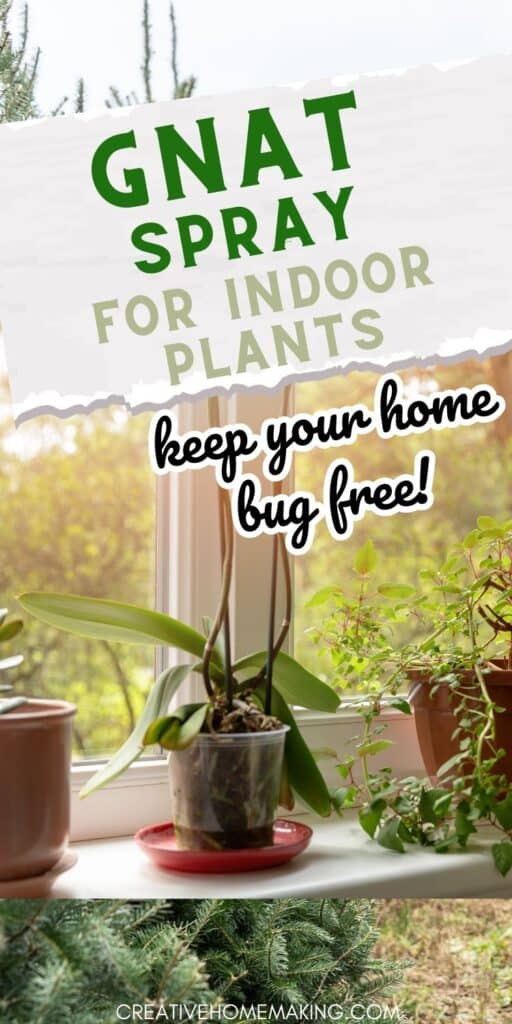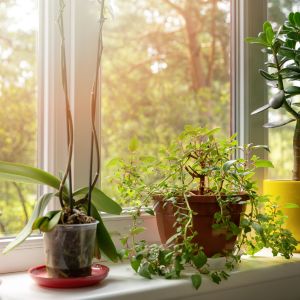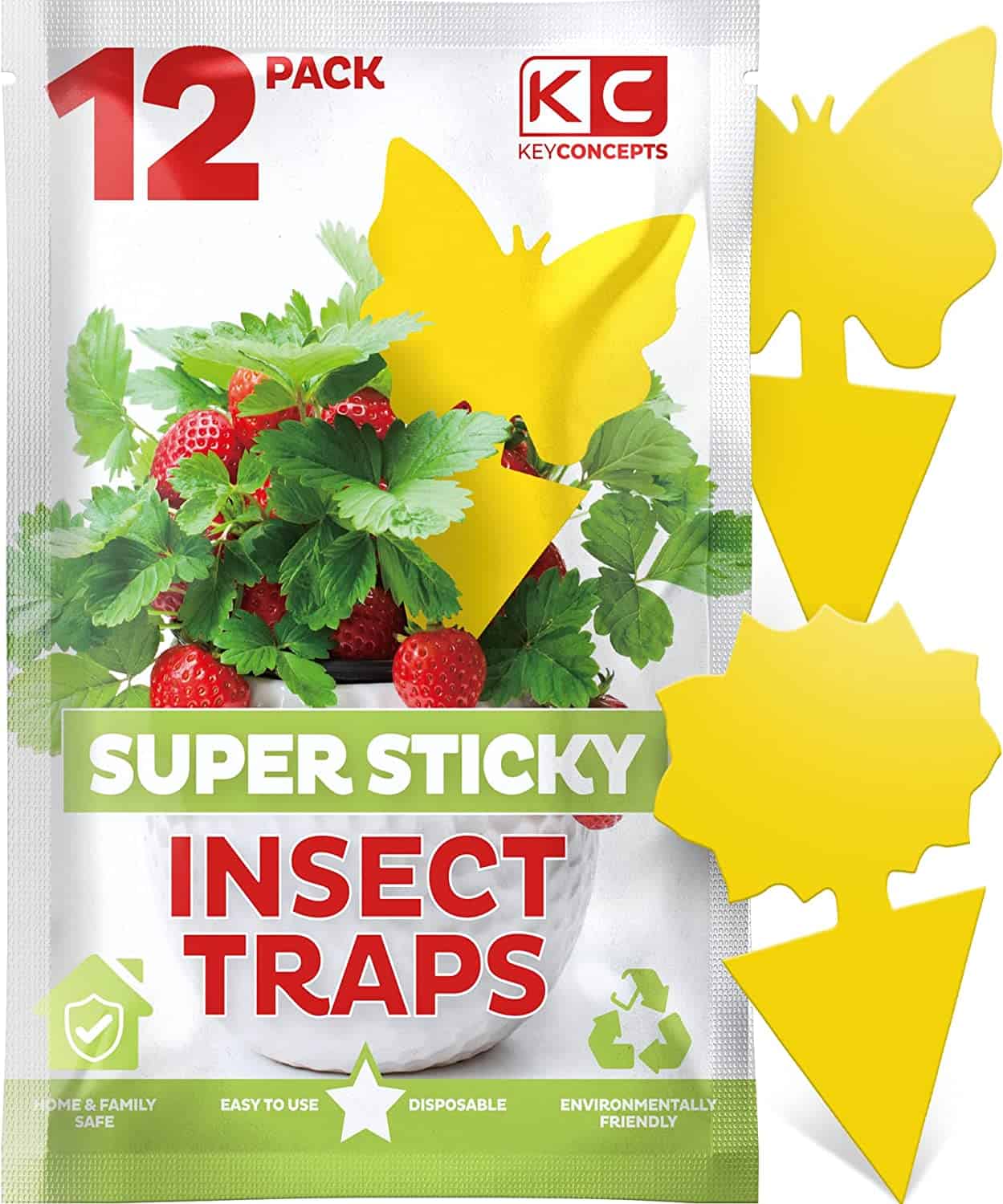If you’re an indoor plant enthusiast, you know that gnats can be a pesky problem. These small, flying insects can quickly take over your plants and cause damage to their roots. Luckily, there are several options for gnat spray that can help you get rid of these unwanted guests.
This post may contain affiliate links.
Understanding Gnats
Gnats are tiny flying insects that are attracted to moist soil and decaying plant material. They are not harmful to humans, but they can be a nuisance to your houseplants.
Related Article: Are Tea Bags Good for Plants? A Guide to Using Tea Bags for Gardening
Gnats are more commonly found in indoor plants because the soil in pots stays moist for longer periods, creating a perfect breeding ground for them. Overwatering your plants can also contribute to the growth of gnats.

Related Article: Home Remedy for Gnats
There are different types of gnats, but the most common ones found in houseplants are fungus gnats.
These gnats feed on fungi that grow in moist soil, and they lay their eggs in the soil as well. When the eggs hatch, the larvae feed on the organic matter in the soil, and the cycle continues.
Gnats can be identified by their small size, typically about 1/8 inch long, and their habit of flying around the soil of your plants. They can also be seen hovering around the leaves of your plants.
It’s important to get rid of gnats as soon as possible because they can multiply quickly and cause damage to your plants. In the next section, we will discuss some effective ways to get rid of gnats in your indoor plants.
Related Article: How to Get Rid of Gnats with Vinegar
Gnat Infestation in Indoor Plants
To prevent and treat a gnat infestation in your indoor plants, there are a few things you can do:
- Allow the soil to dry out between watering to reduce the moisture that gnats need to survive.
- Use yellow sticky traps to catch adult gnats and monitor the infestation.
- Repot your plant with fresh, sterile soil to remove any larvae in the soil.
- Apply a gnat spray specifically designed for indoor plants, following the instructions carefully.
When using any gnat spray, it’s important to read the label and follow the instructions carefully. Some sprays may be harmful to your plants or pets if used improperly.
Related Article: Does Vinegar Keep Mosquitoes Away?
Causes of Gnat Infestation
One of the most common causes of gnat infestation is overwatering your plants. Gnats thrive in moist soil, and overwatering provides the perfect environment for them to breed and lay their eggs.
Make sure to water your plants only when the soil is dry to the touch, and avoid leaving standing water in the saucers.
Another cause of gnat infestation is the presence of organic matter in the soil. Fungus gnat larvae feed on decaying plant matter, so if you have not removed any dead leaves or other plant debris from the soil, it can attract gnats to your plants.
Related Article: How to Get Rid of Gnats in House Plants
Damp soil is another factor that can attract gnats to your indoor plants. If the soil is too damp, it can create the perfect breeding ground for gnats. Make sure to allow the soil to dry out between watering to prevent gnat infestations.
Common Gnat Traps
Dealing with gnats in indoor plants can be frustrating, but there are many common gnat traps that can help you get rid of them. Here are some popular options to consider:
- Sticky Traps: These are adhesive strips or cards that you can place near your plants to trap gnats and other flying insects. They are easy to use and relatively inexpensive. You can find them in various colors, including yellow, which is particularly attractive to gnats.
- DIY Gnat Trap: You can make your own gnat trap using household items. For example, you can fill a shallow dish with apple cider vinegar and a drop of dish soap. The vinegar attracts the gnats, and the soap breaks the surface tension, causing them to drown. You can also use red wine or beer instead of vinegar.
- Candle Trap: Gnats are attracted to light, so you can use a candle trap to lure them away from your plants. Simply light a candle near your plants and wait for the gnats to fly towards it. You can then swat them or use a vacuum cleaner to suck them up.
- Fruit Trap: Gnats are also attracted to ripe or rotting fruit. You can use this to your advantage by placing a piece of fruit in a jar with a narrow opening. Cover the opening with plastic wrap and poke several holes in it. The gnats will be attracted to the fruit and will fly into the jar, where they will be trapped.
- Sticky Fly Traps: These are similar to sticky traps but are larger and can be hung from the ceiling. They are particularly useful if you have a large infestation of gnats.
- Vinegar Trap: Another option is to use a vinegar trap, which is similar to the DIY gnat trap. Simply fill a jar with apple cider vinegar and a drop of dish soap, and cover the opening with plastic wrap. Poke several holes in the plastic wrap, and the gnats will be attracted to the vinegar and will fly into the jar.
Homemade Gnat Sprays
If you’re dealing with a gnat infestation on your indoor plants, it’s important to act quickly. Gnats can quickly spread and damage your plants, so it’s best to address the issue as soon as possible.
Luckily, there are several homemade gnat sprays you can make to get rid of these pesky insects.
Related Article: 6 Natural Fertilizers for Indoor Plants
One effective homemade gnat spray is a mixture of liquid Castile soap, vegetable oil, cayenne pepper, and water. Mix two tablespoons of liquid Castile soap, two tablespoons of vegetable oil, and one teaspoon of cayenne pepper in a gallon of water.
Pour the mixture into a spray bottle and apply it to the leaves of your infested plants.
Another option is a vanilla extract spray. Gnats are repelled by the scent of vanilla, so this spray can be effective in keeping them away. Mix two tablespoons of pure vanilla extract with half a gallon of water and pour it into a spray bottle.
Spray the mixture on your indoor plants to keep the gnats at bay.
You can also make a gnat trap using apple cider vinegar, dish soap, and sugar. Mix a few tablespoons of apple cider vinegar, a few drops of dish soap, and a little sugar in a small saucer.
Place the saucer near the gnats and they will be drawn to the sweet solution. Once they fall in, they will be trapped. Replace the solution often until the gnats are gone.
Related Article: How to Hang Plants from the Ceiling
Commercial Gnat Sprays
When it comes to getting rid of gnats in your indoor plants, commercial gnat sprays can be a great option. These sprays are specially formulated to target gnats and other pests that can harm your plants. Here are a few popular commercial gnat sprays to consider:
Insecticide Sprays
Insecticide sprays are a popular choice for getting rid of gnats in indoor plants. These sprays contain chemicals that are designed to kill gnats and other pests on contact.
However, it’s important to use these sprays with caution, as they can be harmful to pets and humans if ingested.
Related Article: Apple Cider Vinegar Fly Trap: An Effective Homemade Fruit Fly Trap
Neem Oil Sprays
Neem oil is a natural insecticide that is derived from the neem tree. It works by disrupting the life cycle of insects, making it an effective way to get rid of gnats in your indoor plants.
Neem oil sprays are also safe to use around pets and humans, making them a great choice for those who want to avoid harsh chemicals.
Insecticidal Soap Sprays
Insecticidal soap sprays are another natural option for getting rid of gnats in your indoor plants. These sprays contain soap that is designed to suffocate insects, making it an effective way to get rid of gnats without the use of harsh chemicals.
However, it’s important to note that these sprays can also harm beneficial insects, so use them with caution.
Related Article: Gnats in Sink Drain: How to Get Rid of Them
Dealing with Severe Gnat Infestations
If you have a severe gnat infestation in your indoor plants, it can be frustrating and challenging to deal with. However, there are a few things you can do to get rid of gnats and prevent them from coming back.
Make sure to identify the source of the infestation. Gnats are attracted to moist soil, so overwatering your plants can lead to a gnat problem. Additionally, if you have any decaying organic matter in or near your plants, such as dead leaves or fruit, this can attract gnats as well.
Related Article: How to Make Homemade Plant Food
To get rid of gnats, you can use a gnat spray specifically designed for indoor plants. Make sure to follow the instructions on the label carefully and apply the spray evenly to the soil and leaves of your plants. This will kill any adult gnats and prevent them from laying eggs in the soil.
In severe cases, you may need to repot your plants to get rid of the gnat larvae in the soil. When repotting, make sure to remove as much of the old soil as possible and replace it with fresh, dry soil. This will help prevent the gnat larvae from hatching and causing further problems.
Frequently Asked Questions
How can I naturally get rid of gnats in my indoor plants?
There are several natural remedies you can try to get rid of gnats in your indoor plants. One option is to mix a solution of equal parts water and apple cider vinegar, and spray it onto the soil and leaves of your plants.
You can also try using a mixture of water and dish soap, which can help to suffocate the gnats. Another natural remedy is to sprinkle cinnamon powder on the soil, which can help to deter the gnats.
Related Article: How to Make Homemade Plant Food
What is the most effective gnat killer spray for indoor plants?
There are many gnat killer sprays available on the market, but the most effective one for indoor plants is a neem oil-based spray. Neem oil is a natural insecticide that is safe for use on plants and can effectively kill gnats and other pests.
How can I make homemade gnat killer spray for indoor plants?
To make a homemade gnat killer spray, mix one tablespoon of dish soap with one quart of water. Pour the mixture into a spray bottle and spray it onto the soil and leaves of your plants.
You can also add a few drops of essential oil, such as peppermint or lavender, to the mixture to help repel the gnats.
Can coffee grounds be used to get rid of gnats in indoor plants?
Yes, coffee grounds can be used to get rid of gnats in indoor plants. Simply sprinkle used coffee grounds on the soil of your plants.
The caffeine in the coffee can help to kill the gnats, and the grounds can also help to fertilize your plants.
Follow my gardening board on Pinerest.




